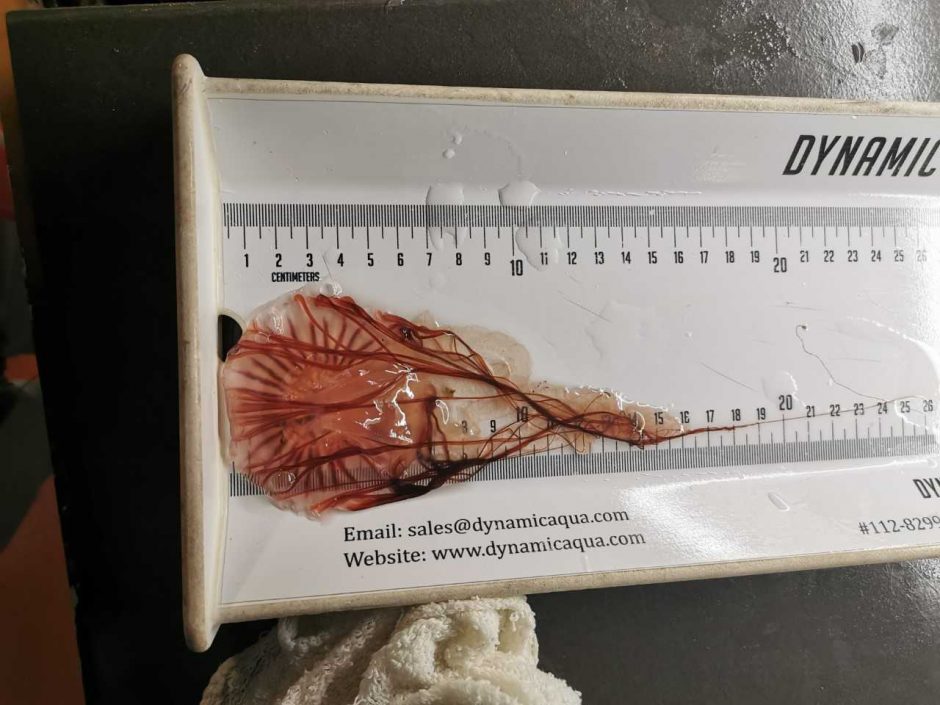Jellyfish have voracious appetites, and they aren’t considered the most selective eaters. Almost anything that gets stuck to their tentacles winds up in the gelatinous sack that they use to digest their food.
This “take what comes” feeding strategy has clouded our understanding of which foods jellyfish survive on and how they fit in food webs. However, new research from the Institute for the Oceans and Fisheries (IOF) used two biochemical tools, stable isotopes and fatty acids, to begin unlocking the secrets of jellyfish feeding.
Stable isotopes are naturally occurring isotopes of elements like carbon and nitrogen that exist in certain ratios in all living tissue. Similarly, fatty acids, which perform several critical physiological functions in the body, are produced in unique compositions by plants at the base of the food web. Unique isotope and fatty acid “signatures”, also known as “biomarkers”, get passed from prey to predator and can be used to trace food web connections and illuminate the makeup of an animal’s diet.
Isotope ratios and fatty acids concentrations change subtly in predictable ways as they travel through the food web. However, these changes, called “calibration values”, can vary from one organism to the next, and knowing an organism-specific calibration values is essential for accurately using biomarkers to investigate diets.

Measuring jellyfish ©Jessica Schaub
“The numbers we found were different enough that it’s worth going back to previous jellyfish studies that applied the general values — they will likely get different results if they applied our values,” Schaub said.
In other words, jellyfish diets could look quite different than expected, and new studies might find that some jellyfish occupy a completely different position in the food web.
The study, published in the Journal of Experimental Marine Biology and Ecology, was a partnership between IOF researchers and the Vancouver Aquarium.
Vancouver Aquarium staff cultured both jellyfish species and fed them two unique crustacean prey diets. The larger and more ferocious Japanese sea nettle were also fed the smaller, more common moon jellyfish. The researchers waited to see how long it took for the jellyfish to incorporate the stable isotopes and fatty acids, and then calculated how much the two biomarkers changed.

Japanese sea nettle ©Jessica Schaub
The study also found that the jellyfish appeared to “elongate” fatty acids. This means that jellyfish may be able to create their own essential omega-3 and omega-6 fatty acids, which are important for healthy body function. This was surprising as most animals cannot make these fatty acids from scratch but have to obtain them from their diets. The phenomenon has been described in a few other organisms, such as corals and sea sponges, but never in jellyfish.
The study’s authors hope that these findings will be a step towards better understanding the role that these understudied creatures play in marine ecosystems.
“Jellyfish have long been ignored in research, often considered more of a nuisance than an organism of interest”, said Dr. Brian Hunt, IOF professor and study co-author. “However, there is a growing awareness that they can play a key role as both predators and prey.”
Schaub will continue to build on this foundational research when she starts her doctoral thesis at the IOF in 2022. “I’m excited to see what we can learn about jellyfish using the biomarkers developed in this study, and I am particularly interested in their role as keystone species that shape marine ecosystems,” she said.
The study’s authors thank the Vancouver Aquarium for providing the jellyfish and assisting them with the experiment, and the Pacific Science Enterprise Center for their assistance in the fatty acid analysis.
Tags: Brian Hunt, faculty, food webs, IOF students, jellyfish, Pelagic Ecosystems Lab, Research, Vancouver Aquarium